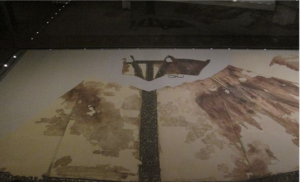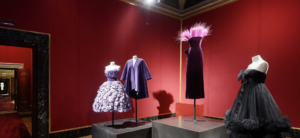The Fusion of Art and Fashion in the Pitti Palace
by Keon Eady
Today on March 13th, we visited the Pitti Palace located in the heart of Florence. Originally built in the 15th century as a lavish Renaissance residence for the powerful Medici family, the palace has since evolved into a renowned cultural institution and a hub for fashion and design dating from the Renaissance to the late 20th century. In this blog post, I’ll explore the fascinating intersection of fashion and history within the walls of the Pitti Palace.
One of the most compelling aspects of fashion in the Pitti Palace is the synergy between art and design. The beautiful art gallery on the first floor created an artistic lens for all its viewers as they made their way through each exhibition. The art gallery was perfectly followed by the Museum of Costume and Fashion. This exhibition featured garments worn by people of the likes of Eleonora di Toledo to garments recently created by designers such as Tom Ford during his stint as the creative designer for Gucci. The pieces depicted fashion through the course of time and with each step, we were able to highlight and recognize the alteration of fashion. Eleonar di Toledo’s garments highlighter how fashion during the medieval period emphasized signifying ones wealth through the amount of textiles and fabrics used to create ones clothing. However, with more contemporary pieces by designers such as Ford, fashion no longer focused on signifying wealth but instead signifying ones ability to be unique.
Each piece of clothing embodied the concept of a designer turning dreams into a tangible piece. Relating this with other events on the trip, designers such as Marco Rambaldi and Francesca Liberatore have emphasized the same idea to us in our interviews with them. Though these designers are relatively small and they may have different approaches to fashion, they both could acknowledge how their is a need to make the unobtainable a tangible image. This goes to show the practicality that this concept has beyond the Pitti Palace.
Past exhibitions have celebrated the work of legendary fashion designers such as Karl Lagerfeld, Christian Louboutin, and Roberto Capucci, showcasing their innovative designs alongside masterpieces from the palace’s vast art collection. This fusion of art and fashion has presented itself many times throughout the trip however the Pitti Palace perfectly demonstrated the parallels between the two. A common question for guests during their interview is if fashion can be considered art. This question is vital to the study of fashion because academics have associated art with something that is not tangible. Ultimately leading to the bigger question: “is fashion is a tangible practice or does it rather create an artistic image of oneself by using the body as a medium?” These questions have shaped not only scholarly studies on fashion but it has also impacted contemporary fashion designs and clothing as we know it. As mentioned previously, each fashion piece in the palace brings a designer’s dream to life through an artistic lens, hence why the Museum of Costume and Fashion proceeds the art gallery. Therefore the palace was a perfect exemplification of the shared relationship between art and fashion and provided great guidance to our mosaic questions surrounding art and fashion.


